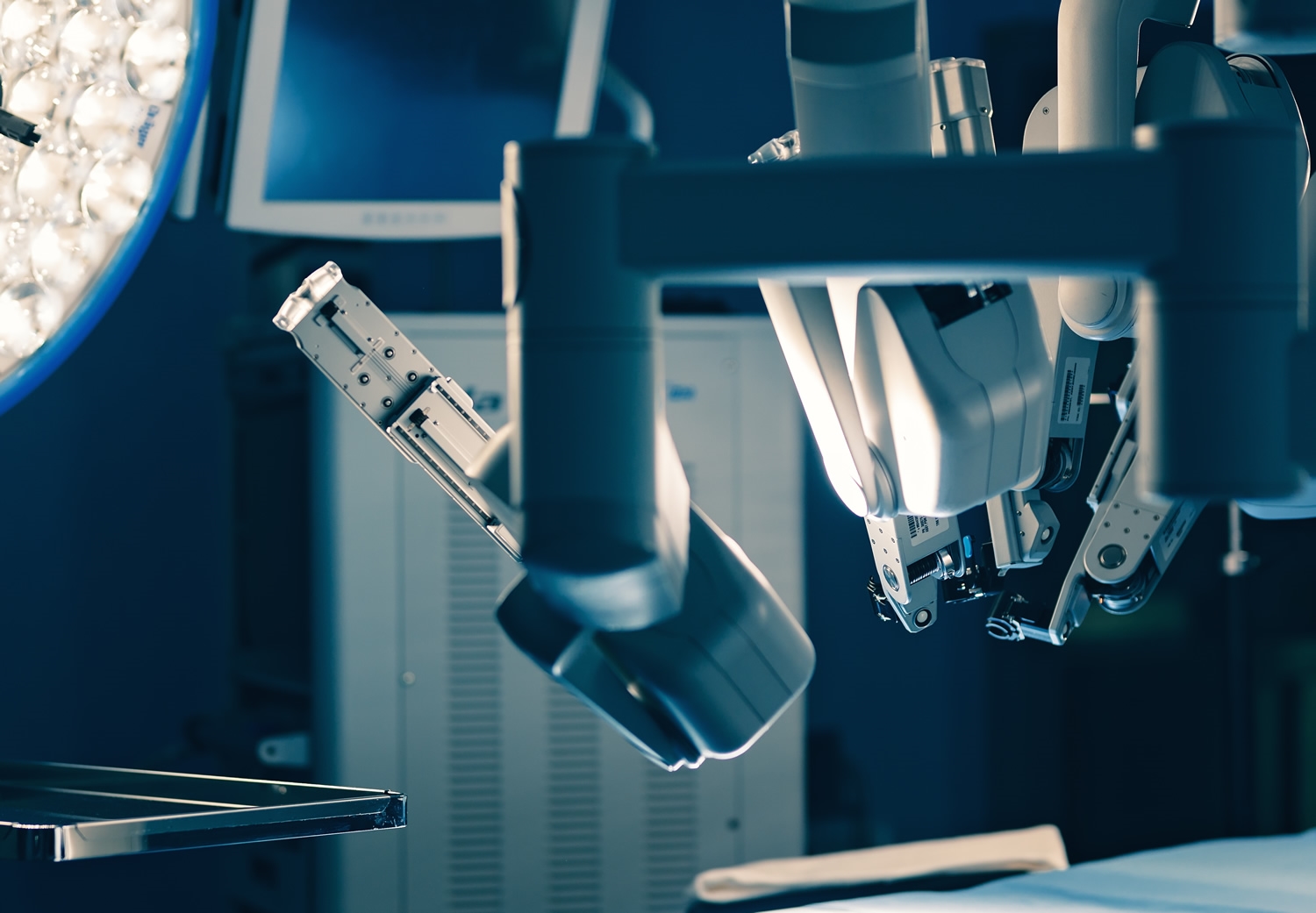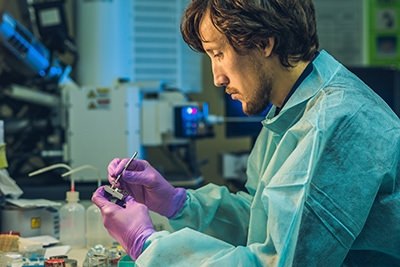Our robot overlords are not arriving soon - irrespective of how much Hollywood profits by suggesting they are. Nor are autonomous nanomachines a thing. Yet.
However, robotics - by which we really mean AI-driven, semi-autonomous machines rather than general capability android servitors - are here and ready to serve. The medical sector is one in which robotics are leaping forward across a surprising range of capabilities and patient treatment/diagnostic roles. From scut-work to patient checking, and from disinfecting to surgery.
Robots in the medical field are transforming how treatment is delivered. They now engage in supply delivery/re-stock and disinfection, are entering diagnostic duties and of course have taken more than tentative steps into live patient surgery. These enhanced uses of robotics increase the ability of caregivers to extend their attention directly engaging with and caring for their patients.
In the real world, intervention with patients and the practice of medicine relies very heavily on people skills, human care, and manual dexterity. But at the margins, in simpler and repetitive tasks, opportunities for robotic assistance abound.
It's also important to note robots save money. Potentially a LOT of money. Most healthcare systems budgets are stretched thin, and personnel are the largest part of their costs. Robots require no rest, have lower maintenance costs and require essentially no pay. That’s attractive to any healthcare system which must make hard choices with limited budgets.
While many fields of medicine benefit, or will, from what we are loosely defining as robotics, two problematic issues persist in the automation of patient physical contact, particularly in the surgical sector:
- Reliability
- Hygiene
Almost nothing is more important in the practice of medicine than clean hands, clean instruments and clean spaces, all functioning precisely. Tissues are easy to damage, infections are easy to transmit and increasingly hard to fight as antibiotic resistance grows. Hygiene is critical to the core purpose of healthcare.
Classifications and Maintenance Challenges of Medical Robots
Medical application robots fall into broad categories that have widely divergent maintenance/hygiene issues and challenges. Although maintenance is critical for all, the scale of maintenance depends on the complexity of the devices.
Tugs, Drones, Skutters, Gofers
The most basic form of automation employed in hospitals and other medical facilities can broadly be thought of as gofers. They go for stuff that’s needed, releasing human staff to perform more human and more challenging tasks.
Think of them as similar to restaurant robots - not capable of loading or unloading - but able to navigate complex and varied spaces with moving obstacles, potentially operating elevators and opening doors.
This type of device has become mundane, as evidenced by their use in waiting at tables. But in reality they’re complex machines developed to solve intricate and variable navigation problems while remaining unobtrusive and operating safely around unpredictable people.
Various maintenance challenges arise as these devices enter the medical field. They may potentially be travelling between public and higher hygiene spaces. They have contact with floors, can pick up detritus and contaminants, they are touched at loading and unloading (and at points between) and can be contaminated by materials they’re transporting - bedding, organic wastes, food and more.
Short of outright breakages, this type of device should pose limited maintenance difficulties - other than hygiene. They’ll require manual or potentially automated washdown - at a frequency and sterilisation depth that is related to the risks they may present. And of course, this is as much a design issue as it is an operational one. The devices must be developed with their long-term use and cleaning front-of-mind, and ideally they should integrate some self awareness as to contamination issues so they can operate more independently, seeking help when they need it.
Space Sterilisation Robots
This is an area of technology penetration into health care that is moving faster than most - because it takes on the unpleasant and yet critical task of bringing consulting, treatment and surgical spaces to the highest levels of hygiene.
CDC data for the US shows that 4% of patients contract hospital-acquired infections such as MRSA and Clostridium Difficile, and around 0.9% of those infected will die as a consequence.
Robotic sterilisers lift the level of hygiene; where people are less methodical, a robot will simply follow instructions as precisely as the environment and its adaptive programming allow resulting in fast and effective disinfection of any healthcare facility. Most of the systems on the market use UV for disinfection, which would be a hazard to a human operator. Use of these systems generally results in 70+% reductions in hospital-acquired infections - which is a huge return on investment.
These devices need a similar maintenance and sterilisation routine to gofers, though not carrying contaminants or foodstuffs and by transiting fewer public spaces they will encounter fewer soiling opportunities.
They are by nature complex machines - not only do they self transport and manage their space interactions, but they must also reach higher, increasing the range of machine functions that must work perfectly for them to serve effectively. Good maintenance and cleaning routines are imperative.
Nurse Assistants RIBA and Robear
One of the most common triggers of absenteeism for general ward nursing staff is spinal injury. This results from the need to manhandle unconscious or restricted mobility patients all day, every day. This is where devices such as RIBA and Robear are increasingly used, as a physical force supplement for nurses. Often not strictly robotic (i.e. with limited or no AI and little independent capability), they are nonetheless the most android-like devices employed in healthcare. They can elevate and reposition patients into and out of bed, into a wheelchair or a bath, assist patients in standing and support walking etc.
Maintenance of these devices is very critical - a device that lifts patients must not drop those patients. They are relatively heavy equipment with high force actuators - yet in direct physical contact with patients - offering many opportunities for accidents - and maintenance is the only way to be sure they’re operating correctly.
Emotional Support Robots
While these are slowly developing supporting data in real operations and only haltingly entering operation, devices such as PARO have reached normalisation in patients’ appreciation in Japan.
PARO is a robotic harbour seal pup that is used with dementia patients and has shown great results in reducing distress. It’s animal therapy without the animal - more predictable, much more hygienic and much lower maintenance than dogs, cats etc.
The plush furred PARO knows its name and responds, shows a pleased response to being stroked, and develops a unique set of personality traits in response to interacting with the patient. Responses such as napping, blinking, waving of flippers and small animal noises are used to simulate vulnerable and affectionate behaviours, in interacting with potentially upset and confused elderly patients.
This type of ‘toy’ device - though of course with complex engineering and therapeutic intent - requires little to no maintenance - other than power supply and cleaning. The devices must be designed with hygiene in mind - a washable fur ‘coat’ and contamination protected workings should be enough to ensure that the robotic therapist does not become the disease vector.
Blood Draw Robots
Every patient is subject to blood draws. Every patient knows that, with the ‘right’ person doing the job it will be painless and quick. Equally, most have had some less than optimal experiences in this, often worsening needle phobias. Often it takes more than one attempt for the phlebotomist to find a suitable vein to carry out the procedure. Blood-drawing robots are increasingly able to reduce the error rate and speed up the process.
These devices use the ‘standard’ sterile and disposable equipment for the blood drawing process, so their ‘function’ represents a relatively simple maintenance task, as the patient contacting materials are consumables. The device itself is undertaking a precise and delicate task, however. Functional performance and cleanliness must be maintained - no sudden movements, facing a nervous patient while holding medical sharps!
Robotic Surgeons / Assistants
A 2016 published Japanese study, performed by Saito et.al. demonstrated that currently available robotic instruments used in surgical procedures are extraordinarily hard to clear of potentially infectious ‘protein’ residues. These essentially first-generation devices have been design-driven by the challenges in developing basic functionality - itself a mountain to climb. Their construction is engineered for micro control first, maintainability second and hygiene a seemingly poor third place.
Cleaning and sterilisation mechanisms are incapable of reaching some internal areas of these complex instruments, particularly where compact drive mechanisms powered by remote actuators transmit forces to the site of surgery. This transmission results in internal lumens (spaces around power transmission components) that can easily become contaminated with protein residues. These devices are not designed with full disassembly capability which would allow direct cleaning of the inner spaces of these lumens. As a result, contaminants can remain on the instrument and moved around during subsequent operation. It isn’t established how much responsibility for post-operative infections may be due to contamination of robot components, but the difference in hygiene levels between robotic instruments and standard manual instruments is concerning. For standard instruments, Saito found the cleaning effectiveness was 99.1%. For robotic instruments, cleaning effectiveness was 97.6%. 97.6% is essentially deeply unhygienic.
The DaVinci surgical robot now has sterilisation routines that are good enough to satisfy the fastidious surgical staff who operate them. Various methodologies have been adopted to suit various patient-contacting elements of the system.
For wound penetrating elements of the robot (clamps, retractors, scalpels, needles etc), manual cleaning is the first step in cleaning and disinfection. All operational elements are modular and can quickly be removed for cleaning, requiring only minimal operator training and the use of a single tool for disassembly and reassembly. The tool itself will require the same sterilisation procedures. Visible residues must be removed by manual washing, with particular focus on module internals to facilitate complete sterilisation.
The disassembled and cleaned modules are then placed in an autoclave deep sterilisation phase which ensures the invisible residues and contaminants are removed and all elements cleaned and sterilised.
Endoscopes are treated in generally similar ways, but their construction is less modular and their internal spaces therefore require flushing. These instruments generally use quick-release mechanisms to remove them from the DaVinci surgical system adapter.
During the process of cleaning after surgery, wash ports are manually flushed with hot water and enzyme-based flush solutions, which can be observed to flow through, demonstrating that there is no internal lumen/gallery blockage. They can then be placed in an ultrasonic bath containing the same enzyme-based cleaning solution and energised for a minimum of 15 minutes. Most enzyme cleaning solutions have a maximum effective operating temperature of 98.6°F (37°C), which must not be exceeded. Outer surfaces must be scrubbed with a soft brush, and then thoroughly rinsed inside and out, to remove cleaning compounds. This intensive manual stage should then be followed up with a normal autoclave cycle, to ensure complete sterilisation.
…
Medical robotics are here to stay. They reduce costs, they improve repeatability of outcomes, and they free medical professionals from mundane tasks and allow more time for patient interaction.
And this has created a whole new industry within healthcare - the medical robotics engineer/technician. The robotic devices are incapable of assessing their own performance or subpar conditions, so maintenance and performance monitoring, hygiene and presentation are critical to the successful outcome of their use as well as patient acceptance of their roles in healthcare.
Ask A Technical Question
Stay up-to-date on Chemtronics news, products, videos & more.



